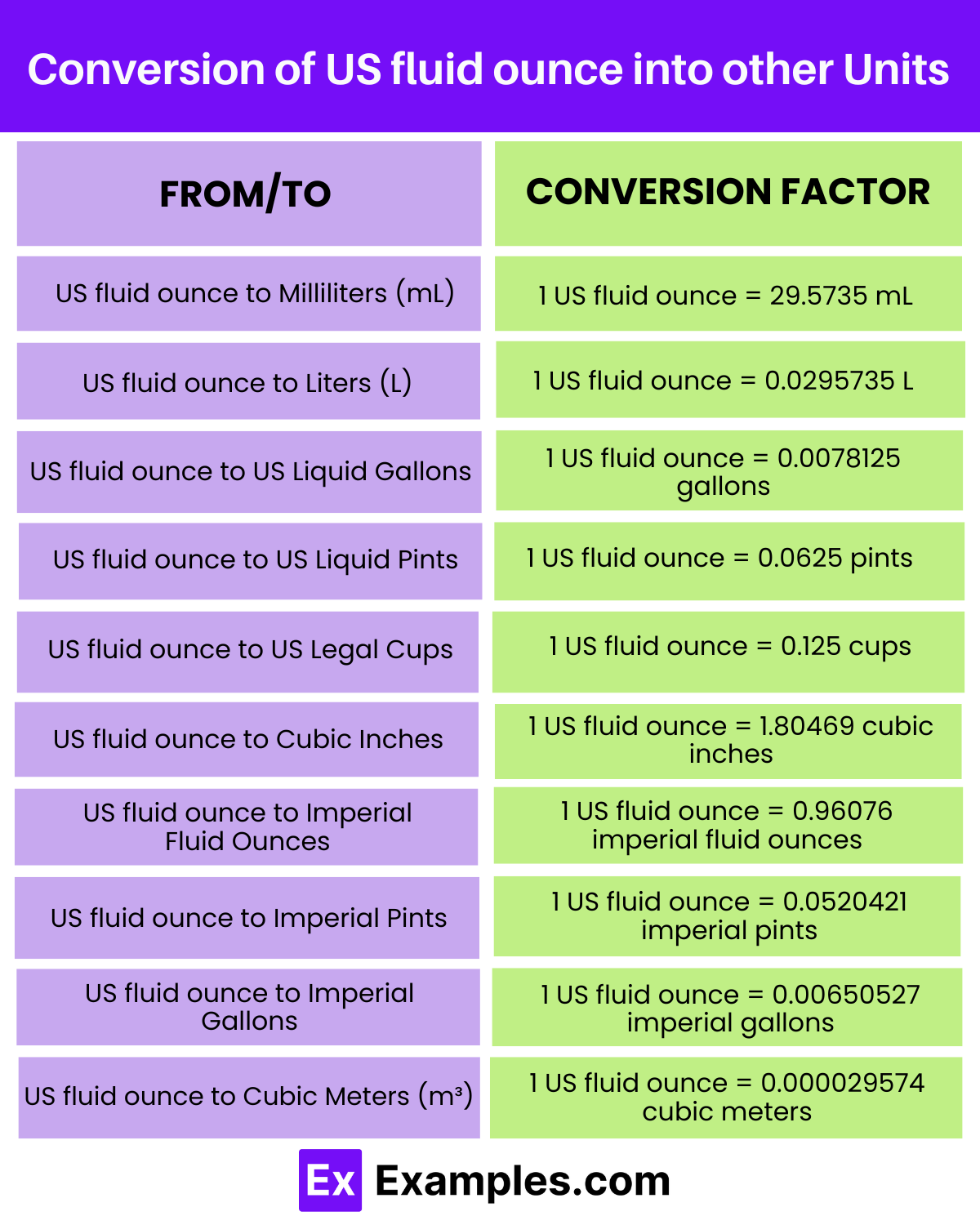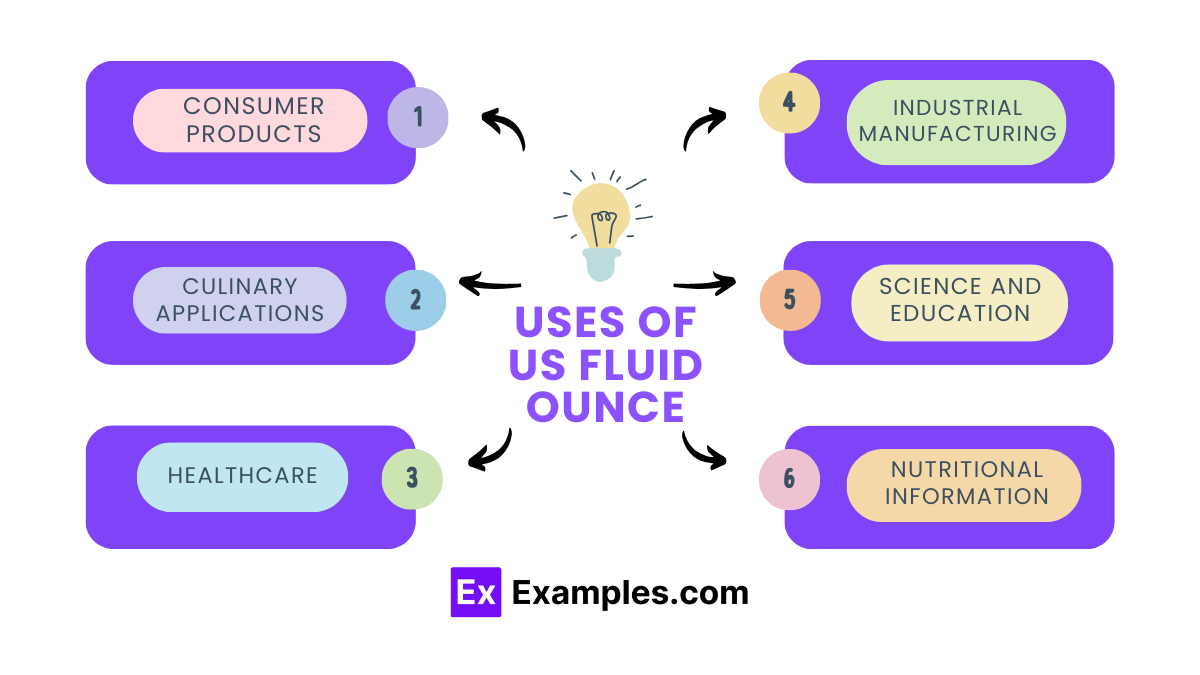What is the abbreviation for US fluid ounce?
fl oz
oz
floz
fz


The US fluid ounce is a units of volume used primarily in the United States to measure liquids. One US fluid ounce is defined as 1/128th of a US liquid gallon, directly tying it to larger volume units used in the US, such as gallons and pints. In more precise terms, one US fluid ounce equals approximately 29.5735 milliliters, linking it to the metric system where volume can also be expressed in liters and cubic meters for broader scientific and international applications. This unit is smaller than the US liquid pint and the US legal cup, which are also commonly used in the United States for culinary and commercial purposes. The understanding and conversion among these units are essential in physics and other sciences where precise volume measurements are crucial.
Scenario: Suppose a doctor prescribes medication that requires you to take 2 US fluid ounces of cough syrup daily.
Application of the Formula: To understand how much this is in milliliters (mL), especially if your measuring tools are marked in metric units, you would use the conversion formula:
Milliliters (mL) = US Fluid Ounces (fl oz)×29.5735
Milliliters (mL) = 2 US fluid ounces×29.5735 mL/fl oz
The calculation shows that if you need to take 2 US fluid ounces of cough syrup, it equates to approximately 59.15 milliliters. This conversion is essential for ensuring you adhere to the correct dosage using metric measurement tools.
Density is defined as the mass per unit volume of a substance. However, the concept of a “density formula” specifically for a US fluid ounce doesn’t directly apply, because a US fluid ounce is a unit of volume, not density. Density depends on both the mass and volume of the substance in question.
To find the density of a liquid (or any substance) measured in US fluid ounces, you would use the general formula for density:
Density = Mass/Volume
If you have the mass of a substance in grams (or any other mass unit) and its volume in US fluid ounces, you can calculate its density. For a practical application, the formula would look like this:
Density (g/mL) = Mass (g)/Volume (US fl oz)×29.5735
Here, the volume in US fluid ounces is converted to milliliters (since there are approximately 29.5735 milliliters in a US fluid ounce) to maintain consistent units for density, typically expressed in grams per milliliter (g/mL).
Suppose you have a container with 8 US fluid ounces of honey weighing 340 grams. To find the density in grams per milliliter:
If you want, I can perform these calculations to show the density of the honey in g/mL.
The concept of “pressure” for a US fluid ounce doesn’t directly apply because a fluid ounce is a measure of volume, not pressure. However, if you’re interested in finding the pressure exerted by a fluid within a container, you would need additional information such as the force with which the fluid is acting on the surfaces of its container and the area of the surface.
To calculate pressure from a volume measurement like a US fluid ounce, you’d need to know:
The formula to find pressure when you have the force and the area is:
P = F/A
Where:
If you want to relate this to a fluid’s volume, such as a US fluid ounce, you’d typically need to:
| SI Prefix | Multiplier | US Fluid Ounce Equivalent in Milliliters |
|---|---|---|
| Kilo- (k) | 10³ | 1 US fluid ounce = 29.5735 mL, so 1 kilo-US fluid ounce = 29,573.5 mL |
| Deca- (da) | 10¹ | 1 US fluid ounce = 29.5735 mL, so 1 deca-US fluid ounce = 295.735 mL |
| Deci- (d) | 10⁻¹ | 1 US fluid ounce = 29.5735 mL, so 1 deci-US fluid ounce = 2.95735 mL |
| Centi- (c) | 10⁻² | 1 US fluid ounce = 29.5735 mL, so 1 centi-US fluid ounce = 0.295735 mL |
| Milli- (m) | 10⁻³ | 1 US fluid ounce = 29.5735 mL, so 1 milli-US fluid ounce = 0.0295735 mL |
| Micro- (μ) | 10⁻⁶ | 1 US fluid ounce = 29.5735 mL, so 1 micro-US fluid ounce = 0.0000295735 mL |

| To Unit | Conversion Factor | Conversion from 10 US fluid ounces |
|---|---|---|
| US fluid ounce to Milliliters (mL) | 1 US fluid ounce = 29.5735 mL | 10 US fluid ounces = 295.735 mL |
| US fluid ounce to Liters (L) | 1 US fluid ounce = 0.0295735 L | 10 US fluid ounces = 0.295735 L |
| US fluid ounce to US Liquid Gallons | 1 US fluid ounce = 0.0078125 gallons | 10 US fluid ounces = 0.078125 gallons |
| US fluid ounce to US Liquid Pints | 1 US fluid ounce = 0.0625 pints | 10 US fluid ounces = 0.625 pints |
| US fluid ounce to US Legal Cups | 1 US fluid ounce = 0.125 cups | 10 US fluid ounces = 1.25 cups |
| US fluid ounce to Cubic Inches | 1 US fluid ounce = 1.80469 cubic inches | 10 US fluid ounces = 18.0469 cubic inches |
| US fluid ounce to Imperial Fluid Ounces | 1 US fluid ounce = 0.96076 imperial fluid ounces | 10 US fluid ounces = 9.6076 imperial fluid ounces |
| US fluid ounce to Imperial Pints | 1 US fluid ounce = 0.0520421 imperial pints | 10 US fluid ounces = 0.520421 imperial pints |
| US fluid ounce to Imperial Gallons | 1 US fluid ounce = 0.00650527 imperial gallons | 10 US fluid ounces = 0.0650527 imperial gallons |
| US fluid ounce to Cubic Meters (m³) | 1 US fluid ounce = 0.000029574 cubic meters | 10 US fluid ounces = 0.00029574 cubic meters |
As a larger unit of volume in the metric system, liters are used for measuring bigger quantities of liquids, such as beverages and automotive fluids. The conversion from US fluid ounces to liters facilitates larger-scale applications and aligns with international standards.
As a larger unit of volume in the metric system, liters are used for measuring bigger quantities of liquids, such as beverages and automotive fluids. The conversion from US fluid ounces to liters facilitates larger-scale applications and aligns with international standards.
This unit is used predominantly in the United States for measuring larger volumes of liquids, especially in commercial transactions and fuel measurements. Converting US fluid ounces to gallons is essential for bulk handling and distribution of liquids.
Often used in the culinary and beverage industries, the US liquid pint is a practical measure for serving sizes. Conversion from US fluid ounces to pints is particularly useful in settings like restaurants and pubs.
In recipes and everyday cooking, the US cup is a standard measure. Converting US fluid ounces to cups aids in culinary accuracy and recipe standardization.
This unit is typically used in engineering and manufacturing for non-liquid volumes but can also apply to liquid in container capacity calculations. The conversion helps in technical designs and crafting precision components.
These units are used primarily in countries that are on the imperial system for recipes, and other liquid measurements. Conversion from US fluid ounces helps in maintaining accuracy when using or interpreting recipes and measurements from such countries.
These units are used primarily in countries that are on the imperial system for recipes, and other liquid measurements. Conversion from US fluid ounces helps in maintaining accuracy when using or interpreting recipes and measurements from such countries.
These units are used primarily in countries that are on the imperial system for recipes, and other liquid measurements. Conversion from US fluid ounces helps in maintaining accuracy when using or interpreting recipes and measurements from such countries.
The largest standard unit for volume in the metric system, used extensively in industry and commerce for large-scale transactions and public supply measurements like water delivery. The conversion from US fluid ounces to cubic meters supports operational and logistical activities on an industrial scale.

The US fluid ounce is a legal requirement for labeling the volume of liquids on consumer goods in the United States.
Yes, but conversion may be necessary. Recipes from countries that use the metric system or the Imperial system will require conversion to US fluid ounces for accurate measurement.
A US fluid ounce is a unit of volume equal to approximately 29.5735 milliliters, commonly used in the United States to measure liquids.
Text prompt
Add Tone
10 Examples of Public speaking
20 Examples of Gas lighting
What is the abbreviation for US fluid ounce?
fl oz
oz
floz
fz
How many milliliters are in one US fluid ounce?
30 mL
29.5735 mL
28.3495 mL
31.1035 mL
How many US fluid ounces are there in one US gallon?
64 fl oz
128 fl oz
96 fl oz
32 fl oz
What is the equivalent of one US fluid ounce in liters?
0.001 L
0.0295735 L
0.1 L
0.5 L
How many US fluid ounces are in one US pint?
8 fl oz
16 fl oz
12 fl oz
24 fl oz
What is the volume of two US fluid ounces in milliliters?
59.147 mL
50 mL
60 mL
58 mL
How many US fluid ounces are in one cup?
4 fl oz
6 fl oz
8 fl oz
10 fl oz
Convert 500 mL to US fluid ounces.
16.91 fl oz
17.59 fl oz
18.94 fl oz
19.36 fl oz
How many US fluid ounces are in one quart?
16 fl oz
32 fl oz
40 fl oz
24 fl oz
What is the equivalent of three US fluid ounces in liters?
0.0887205 L
0.1 L
0.09 L
0.085 L
Before you leave, take our quick quiz to enhance your learning!

